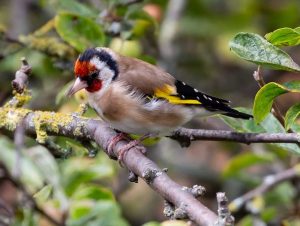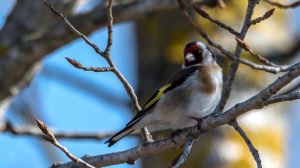It is quite easy to spot goldfinches at your feeding tables, the adults are anyhow, with their bright red faces and black caps. Such pretty small birds, slightly smaller than the robin, with their melodic, twittering song.
I don’t seem to have many of the charming little fellas in my garden, which made me wonder, are goldfinches in decline, or have my local birds found a better food source elsewhere?

Happily, goldfinch numbers are quite healthy. There are approximately 1.2 million pairs in the UK that can be seen almost everywhere except for the most mountainous regions of Scotland.
It is thought that since the 1970s, the British goldfinch population has doubled.
Table of Contents
Finches and Disease
The chaffinch and greenfinch are both extremely susceptible to trichomonosis, causing a devastating effect on their population.
Fortunately, the goldfinch hasn’t suffered the same fate. Although they can catch the disease, they seem better designed to stave it off. Combine that with the fact that they are capable of multiple broods each year, each with 5 or 6 young, and you have an explanation for their consistent numbers.
Trichomonosis
It is a parasite borne disease that affects several species of garden birds, but in particular finches, house sparrows, siskins, great tits, and dunnocks.
It affects the back of their throats and gullets, leaving them with breathing and swallowing difficulties. Birds with trichomonosis tend to look ill, they’re lethargic and their plumage fluffs up.
They are ill for a few days, maybe weeks before they succumb to the disease.
How to prevent the spread of disease in our finches
Feeding the birds is more than a pastime, it is essential to supplement their diets to prevent the decline of the goldfinch and other similar species.
The disease is most likely transmitted through contaminated food. An infected bird attempts to eat and then regurgitates as it struggles to swallow. Another bird inadvertently eats that seed.

The best way to prevent this happening is to keep our feeders and tables as clean as possible.
A solution of 1 part bleach in 20 parts water is perfect. Once everything is clean, rinse it thoroughly before allowing it to air dry.
Although the goldfinch isn’t the finch most susceptible to the disease currently, in years to come things may change. We should all do our best to protect this beautiful species from harm.
Why are goldfinches not using our feeders
If there are as many goldfinches around as in recent years and you’re still failing to attract them to your garden, oddly, it could be a good thing.
It usually signifies that there is an abundance of natural food available elsewhere.
This usually occurs when summer has been long and autumn and winter are mild. The goldfinch and their purpose-designed, tough beak will have copious amounts of thistles and teasels to feed from.
The mild climate also encourages fine fruit, berry, and seed crops. Anywhere berries are rife, so are insects, the main ingredient that breeding goldfinches feed their young.
Goldfinches aren’t ignoring your feeders, they don’t have any need for them.
Remember, humans just supplement the bird’s diets.
Final thoughts
Thanks for taking the time to read “are goldfinches in decline?”
It makes me happy to know that they’re not, and to know that we can do our bit to ensure they don’t become endangered in the near future.
I think I am just going to keep my niger seed feeder topped up in the hope of dragging one or two away from the woodland for me to get a closer look at.

Hi Walter, I came home from work today and there was a goldfinch sitting on my fence watching me as I got out of my car. I am growing wildflowers in my front garden, which includes the odd thistle and some ragwort in the grass (which I detest but if the finches like it I’ll keep it for them. I am in the West Midlands and it was my first time seeing one in my garden.